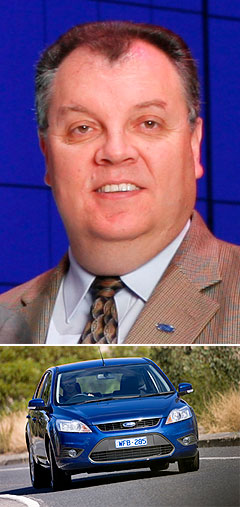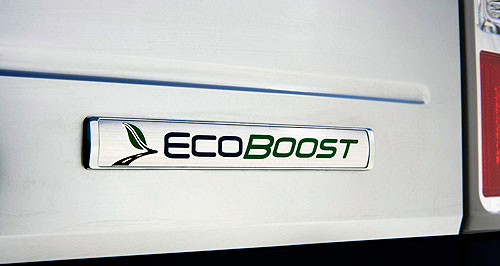Future models - Ford - FalconFalcon ‘four’ guns for fleetsSign of the times: Ford's EcoBoost turbo technology will be introduced in a four-cylinder Falcon. Ford aims to recapture fleet business with fuel-friendly EcoBoost four-cylinder27 Jul 2009 FORD Australia is confident the upcoming four-cylinder EcoBoost engine will secure the future of the Falcon by wooing lucrative business and government fleets that have closed the door on six cylinders. The company announced last week that it would introduce the first four-cylinder Falcon in March 2011, with fuel economy gains of between 15 and 20 per cent. It has also confirmed the introduction of a lean liquid injection LPG E-Gas Falcon in July 2010 and a six-cylinder diesel engine in the Territory SUV from 2011 – a year later than expected. Rival Holden is just weeks away from announcing a new 3.0-litre version of the its Melbourne-made V6 as part of a range of fuel-saving measures for Commodore. Ford Australia president Marin Burela said the investment of $230 million in new powertrains for its locally made models opened up a “whole new world” of opportunity. He played down the cancellation of the Focus small car production program that was due to boost local production by at least 40,000 cars a year from 2011.  Left: Ford Australia president Marin Burela. Below: The Ford Focus. Left: Ford Australia president Marin Burela. Below: The Ford Focus.Mr Burela did not specify how many extra sales would come from introducing a four-cylinder Falcon, but he did say the new engine would make the car more attractive to certain fleets, including those of governments, many of which had previously banned six cylinders. “When I look at government, where we have not been able to participate, we have now opened up the door for a discussion that we have not been able to have in the past,” Mr Burela said. He said the new liquid-injection single-fuel LPG system, which promises to deliver the same power and torque as the petrol engine but use 12 per cent less fuel than the existing E-Gas system, will also make the Falcon more appealing to businesses, while the diesel V6 would greatly expand the reach of the Territory. Mr Burela said Ford Australia engineers would also make further improvements to the I6 petrol engine to further reduce its fuel consumption, but refused to go into detail of the proposed changes. But there is no question the EcoBoost four cylinder is the star of the announcement, with Ford keen to point out the Falcon will be the first rear-drive car in the world to run the four-cylinder EcoBoost engine. Mr Burela promised the efficient powerplant would be an affordable option and that it would be made available on several models, including the base XT, although the first application would be for G6 and G6E models. “Let’s get it into G-Series, that is the first step, put it next to the I6 which is even more competitive than it is today and go out there and give people the choice,” he said. “We are going to go out there and provide it as an option to people so they can decide what they want to do.” While he said it was far too early to start talking about prices, Mr Burela said the EcoBoost engine would not be prohibitively expensive. “The whole strategy behind EcoBoost is to provide affordable motoring to people in this current age,” he said. “This is not about bringing in technology that is not affordable for mums and dads of Australia. “This is about providing an engine, fuel economy and emission reductions that they can buy into.” While a 2.0-litre four-cylinder engine option could increase the appeal of the Falcon in Asia and Europe, Ford Australia said the decision to introduce the EcoBoost powerplant was not based on increased exports. The US-developed EcoBoost engine teams direct injection technology with a high compression ratio and a turbocharger. When presented in Detroit last week, Ford said the engine would produce a minimum of 170kW of power and 325Nm of torque. This places it below the current Australian naturally aspirated I6 output of 195kW and 391Nm. Ford said the engine would have similar performance to a ‘high-tech’ naturally aspirated 3.0-litre V6 and produce its peak torque from just 1500rpm all the way through to 5500rpm. Plus, it would have better fuel economy. “We get a fuel economy benefit regardless of the cycle, whether you are cruising, idling, accelerating, there is an equivalent sized naturally aspirated V6,” said chief engineer for Ford Asia Pacific and South Africa, Rob Conner. He refused to comment on whether the new four-cylinder engine could match the performance of Ford’s torquey I6, but said there was no downside to the EcoBoost engine plan. “It is going to have fuel economy and emissions of a four cylinder and the performance that people expect from a six cylinder engine, so there really is no compromise, no downside as far as the consumer is concerned.” He said the EcoBoost four cylinder engine would meet the needs of Australian customers and should also be capable of towing heavy loads. “There is also no trade off in terms of the utility. This market in particular has an emphasis on trailer towing and this (EcoBoost) is competitive with diesels and, I can say, having seen the data, competitive with (petrol) six cylinder engines as well,” he said. While Mr Conner is confident real-world testing will replicate the computer simulations, he did let on that Ford has yet to install the engine in a Falcon. “We are about two weeks away from having a drive,” he said.  Read more24th of July 2009  Ford confirms four-pot Falcon, dumps Focus planAustralian Focus production plan abandoned as Ford announces four-cylinder FalconAll future models Alfa Romeo Alfa Romeo Abarth Abarth Audi Audi Aston Martin Aston Martin BMW BMW Bentley Bentley Chrysler Chrysler Chevrolet Chevrolet Dodge Dodge Citroen Citroen Ferrari Ferrari DS DS Ford Ford Fiat Fiat FPV FPV Foton Foton Haval Haval Great Wall Great Wall Honda Honda Holden Holden Hyundai Hyundai HSV HSV Isuzu Isuzu Infiniti Infiniti Jeep Jeep Jaguar Jaguar Lamborghini Lamborghini Kia Kia Lexus Lexus Land Rover Land Rover Mazda Mazda Maserati Maserati Mercedes-Benz Mercedes-Benz McLaren McLaren Mini Mini Nissan Nissan Mitsubishi Mitsubishi Peugeot Peugeot Opel Opel Proton Proton Porsche Porsche Renault Renault Ram Ram Saab Saab Rolls-Royce Rolls-Royce Smart Smart Skoda Skoda Subaru Subaru SsangYong SsangYong Tesla Tesla Suzuki Suzuki Toyota Toyota Volvo VolvoMotor industry news |
Click to shareFord modelsResearch Ford All future models Alfa Romeo Alfa Romeo Abarth Abarth Audi Audi Aston Martin Aston Martin BMW BMW Bentley Bentley Chrysler Chrysler Chevrolet Chevrolet Dodge Dodge Citroen Citroen Ferrari Ferrari DS DS Ford Ford Fiat Fiat FPV FPV Foton Foton Haval Haval Great Wall Great Wall Honda Honda Holden Holden Hyundai Hyundai HSV HSV Isuzu Isuzu Infiniti Infiniti Jeep Jeep Jaguar Jaguar Lamborghini Lamborghini Kia Kia Lexus Lexus Land Rover Land Rover Mazda Mazda Maserati Maserati Mercedes-Benz Mercedes-Benz McLaren McLaren Mini Mini Nissan Nissan Mitsubishi Mitsubishi Peugeot Peugeot Opel Opel Proton Proton Porsche Porsche Renault Renault Ram Ram Saab Saab Rolls-Royce Rolls-Royce Smart Smart Skoda Skoda Subaru Subaru SsangYong SsangYong Tesla Tesla Suzuki Suzuki Toyota Toyota Volvo VolvoMotor industry news |
















Facebook Twitter Instagram